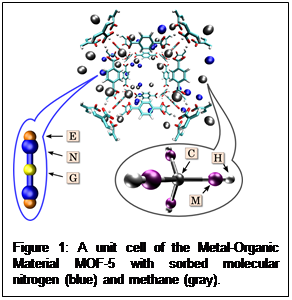Simulation and Rational Design of Metal-Organic Materials
Brian Space, Professor
Department of Chemistry
University of South Florida, Tampa, Florida 33620
bspace@mail.usf.edu; (813) 765-4846
 Overview of the Space research group: The Space group is a theoretical chemistry group concerned primarily with computer simulation of condensed phase phenomena. Current focus is on the development of highly accurate potential energy functions for environmentally relevant gases, such as carbon dioxide, hydrogen, nitrogen, methane, oxygen and associated oxides. The potentials are used in molecular simulations of sorption of such gases within metal-organic materials, or MOMs. MOMs are solid, 3D crystalline materials that are constructed with organic ligands linked to metal-containing clusters. They offer great potential as H2 storage, CO2 capture and N2/CO2/CH4/O2 separation platforms. Additionally, they are lightweight, can be intelligently engineered to have large surface areas and can be assembled from molecular building blocks with desired chemical functionality. Computation is a highly effective tool for this, and could lead to the discovery of new, useful MOMs.
Overview of the Space research group: The Space group is a theoretical chemistry group concerned primarily with computer simulation of condensed phase phenomena. Current focus is on the development of highly accurate potential energy functions for environmentally relevant gases, such as carbon dioxide, hydrogen, nitrogen, methane, oxygen and associated oxides. The potentials are used in molecular simulations of sorption of such gases within metal-organic materials, or MOMs. MOMs are solid, 3D crystalline materials that are constructed with organic ligands linked to metal-containing clusters. They offer great potential as H2 storage, CO2 capture and N2/CO2/CH4/O2 separation platforms. Additionally, they are lightweight, can be intelligently engineered to have large surface areas and can be assembled from molecular building blocks with desired chemical functionality. Computation is a highly effective tool for this, and could lead to the discovery of new, useful MOMs.
Teacher Project: Understanding the Nature of Gas Sorption in Metal-Organic Materials for the Theoretical Design of New Materials
During the 7-week project, the teacher will perform computer simulations of gas sorption in various MOMs. The teacher will work alongside a graduate student to get acquainted with molecular simulation and the specific software that will be used. Data analysis will be used to characterize each material and quantify the sorbate uptake. Advanced visualization software will also be used. While at first the materials used in simulation will be those that have already been synthesized experimentally, theoretically proposed structures will be designed and simulated as well. Intelligently chosen metal ion and organic linker substitution, based on data and structure analysis, will be the chemical modifications made when designing new and insightful materials. While it is estimated that a few rationally designed materials can be created and used in simulation during 7-week timespan, the project has potential for continued growth and its point of termination will therefore depend on the teacher’s progress.
All the tools needed for the teacher to begin the project immediately will be provided. A computer workstation along with user accounts at a couple high performance computing centers will be set up. The first few days will consist of becoming familiar with the software used and the theory of our simulation methods. Reading of a few relevant journal articles will be necessary. At least one to two other graduate students will be directly involved with the project as well. All remaining graduate students in the lab will be working on related projects and therefore will be available to answer any questions throughout the duration of the project. Depending upon progress, co-authorship of a conference presentation and a journal article are possible for the teacher.
- 1. Upconversion Photocatalysis for Energy and Environmental Applications
- 2. Sorption of Organic Vapors by Polymers using a Quartz Crystal Microbalance
- 3. Effective Deposition and Spreading of Powder Layers for 3D Printing
- 4. Synthesis and Characterization of Structured Nanomaterials for Energy Applications
- 5. Syntheses and Characterizations of Catalytically Active Porous Metal-Organic Frameworks (MOFs)
- 6. Microfluidic Filtration of Circulating Tumor Cells
- 7. Simulation and Rational Design of Metal-Organic Materials
- 8. Composition of Organic and Inorganic Polymeric Nanofibers for Filtering, Tissue Scaffolding, Wavelength Reflecting, and Self-healing Functionalities
- 9. Dynamic Tissue Cultures for Cell Printing
- 10. Synthesis and Characterization of Nanocomposites for 3D Printed RF Devices